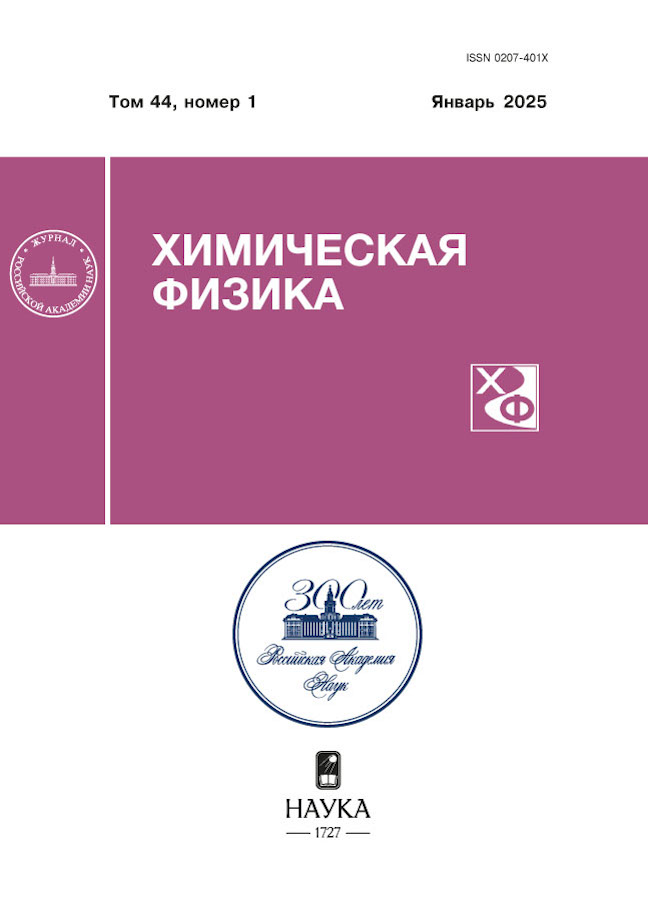Quantum chemical simulation of reactions in a nanogold–oxygen–hydrogen system
- Authors: Grishin M.V.1, Baimukhambetova D.T.1, Gatin A.K.1, Sarvadii S.Y.1, Slutskii V.G.1, Kharitonov V.А.1
-
Affiliations:
- Semenov Research Center for Chemical Physics, Russian Academy of Sciences
- Issue: Vol 44, No 1 (2025)
- Pages: 44-51
- Section: Kinetics and mechanism of chemical reactions, catalysis
- URL: https://rjmseer.com/0207-401X/article/view/683321
- DOI: https://doi.org/10.31857/S0207401X25010056
- ID: 683321
Cite item
Abstract
Quantum chemical calculations are performed to determine the heats of adsorption of H2 and O2 on the simplest electrically neutral Au3 cluster or the negatively charged Au3- cluster. A detailed mechanism is proposed for reaction between O2 and (Au3H2) adsorbate, and the energy budget for the elementary reactions producing (Au3O)- and H2O is calculated. The energy budget is also calculated for the elementary steps involved in the reaction between (Au3O)- and H2 producing Au3- and H2O. Based on the calculated results, an explanation is proposed for the experimental data on interaction of hydrogen and oxygen with gold nanoparticles deposited on pyrolytic graphite. Since the gold nanoparticles located on graphite are negatively charged, the calculations are performed accordingly for negatively charged gold-containing particles.
Full Text
About the authors
M. V. Grishin
Semenov Research Center for Chemical Physics, Russian Academy of Sciences
Email: slutsky@chph.ras.ru
Russian Federation, Moscow, 119991
D. T. Baimukhambetova
Semenov Research Center for Chemical Physics, Russian Academy of Sciences
Email: slutsky@chph.ras.ru
Russian Federation, Moscow, 119991
A. K. Gatin
Semenov Research Center for Chemical Physics, Russian Academy of Sciences
Email: slutsky@chph.ras.ru
Russian Federation, Moscow, 119991
S. Yu. Sarvadii
Semenov Research Center for Chemical Physics, Russian Academy of Sciences
Email: slutsky@chph.ras.ru
Russian Federation, Moscow, 119991
V. G. Slutskii
Semenov Research Center for Chemical Physics, Russian Academy of Sciences
Author for correspondence.
Email: slutsky@chph.ras.ru
Russian Federation, Moscow, 119991
V. А. Kharitonov
Semenov Research Center for Chemical Physics, Russian Academy of Sciences
Email: slutsky@chph.ras.ru
Russian Federation, Moscow, 119991
References
- Wittstock, V. Zielasek, J. Biener, C.M. Friend, M. Baumer. Science. 327, 319(2010). https://doi.org/10.1126/science.1183591
- Raptis, H. Garcia, M. Stratakis. Angew. Chem. Int. Ed. 48, 3133(2009). https://doi.org/10.1002/anie.200805838
- S.F.R. Taylor, J. Sa, C. Hardacre C. ChemCatChem. 3 119 (2011). https://doi.org/10.1002/cctc.201000337
- Y. Zhu, L. Tian, Z. Jiang, S. Pei, S. Xie, M. Qiao, K. Fan. J. Catal. 281, 106(2011). https://doi.org/10.1016/j.jcat.2011.04.007
- Corma, P. Serna. Science. 313, 332(2006). https://doi.org/10.1126/science.1128383
- A.K. Gatin, M.V. Grishin, N.V. Dokhlikova, A.A. Kirsankin, N.N. Kolchenko, V.A. Kharitonov, B.R. Shub, S.A. Gurevich, V.M. Kozhevin, D.A. Yavsin, T.N. Rostovshchikova. Russian Chemical Bulletin. 63(8) 1696(2014). https://doi.org/10.1007/s11172-014-0655-y
- V.M. Kozhevin, D.A. Yavsin, V.M. Kouznetsov, V.M. Busov, V.M. Mikushkin, S.Yu. Nikonov, S.A. Gurevich, A. Kolobov. J. Vac. Sci. Techn. B. 18, 1402(2000). https://doi.org/10.1116/1.591393
- M.V. Grishin, A. K.Gatin, V.G. Slutskii, A.S. Fedotov, V.A. Kharitonov, B.R Shub. Russian Journal of Physical Chemistry B. 16(3), 395(2022). https://doi.org/10.1134/s1990793122030150
- M.V. Grishin, A. K.Gatin, V.G. Slutskii, A.S. Fedotov, V.A. Kharitonov, B.R Shub. Russian Journal of Physical Chemistry B. 17(1), 49(2023). https://doi.org/10.1134/s1990793123010050
- M.V. Grishin, A.K. Gatin, V.A. Kharitonov, S.A. Ozerin, S.Yu. Sarvadii, B.R. Shub.// Russian Journal of Physical Chemistry B. 16(2), 211(2022). https://doi.org/10.1134/S199079312232001X
- N.V. Dokhlikova, A.K. Gatin, S.Yu. Sarvadiy, S.A. Ozerin, E.I. Rudenko, M.V. Grishin, B.R. Shub. Russian Journal of Physical Chemistry B. 16(4), 722(2022). https://doi.org/10.1134/s1990793122040042
- T. Ozaki. Phys. Rev. B. 67, 155108(2003). https://doi.org/10.1103/PhysRevB.67.155108
- T. Ozaki, H. Kino. Phys. Rev. B. 69, 195113(2004). https://doi.org/10.1103/PhysRevB.69.195113
- L.N. Rosanov. Vakuumnaya Tehnika, 2-nd Edition. Moscow, Vysshaya Shkola, 1990. 220 P. [in Russian].
Supplementary files














